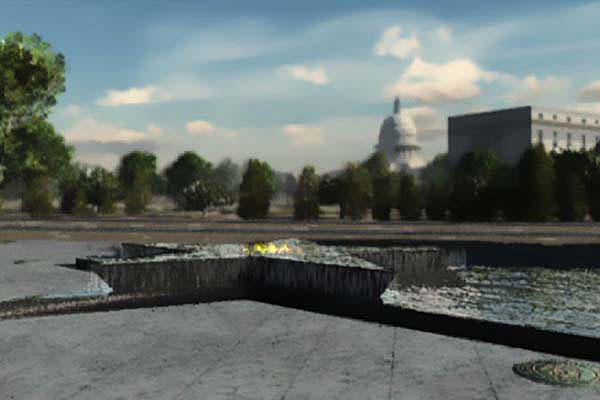ATLANTA -- A different kind of war memorial will open to the public next year in Washington, D.C.
It may be the most unique tribute to veterans since the Vietnam Veterans Memorial Fund surprised the design world by building the somber and powerful wall of names more than 30 years ago. Unlike the Vietnam Wall and scores of other memorials, this one will honor wounded warriors.
“You had your whole lives ahead of you, but you were willing to risk all of it for this land that we love,” President Obama said on Saturday to more than 3,000 veterans who gathered here for the Disabled American Veterans national convention. “And next year, your profound sacrifice will be recognized in the heart of our nation’s capital when our country dedicates the American Veterans Disabled for Life Memorial.”
The $81.5 million memorial, which will feature 48 glass display panels, will open on Oct. 12, 2014, according to the Disabled Veterans' Life Memorial Foundation. It will sit on a 2.4-acre site across from the U.S. Botanic Garden. Its centerpiece will be a star-shaped fountain -- each point representing a service branch -- and pool that will capture the reflection of the nearby U.S. Capitol.
“We looked at 22 sites that were given to us by the National Park Service. We selected [the C Street] location because of its proximity to the U.S. Capitol,” said Rick Fenstermacher, chief executive officer for the project. “We wanted Congress to be able to look at the memorial and see that the cost of war is more than [the price] of bullets and bombs.”
Inscribed on the thick, transparent panels will be quotations that help tell the story of war’s wounded and crippled, along with historic images of servicemembers and veterans reproduced from archival photos. Behind the images -- seen through the transparent panels -- will be bronze sculptures depicting the returned wounded veterans.
For Barry Owenby, the construction marks his second turn as project executive on a major memorial for veterans in Washington. Owenby also was project director for the World War II Memorial.
A common question Owenby has received thus far has been: “Where do the names go?”
Since the Vietnam War Memorial went up three decades ago, there is often a perception among many that a memorial will, or should, include the names of those being memorialized. But with more than 400,000 American troops killed in World War II and nearly 700,000 others wounded, Owenby said he had to explain to some that “there’s not enough room.”
That’s even truer in the case of a memorial to disabled veterans, of which there are currently more than 3 million, he said.
The foundation behind the project was established in 1998, largely through the drive and initial funding of Lois Pope, a Florida philanthropist. Pope previously told interviewers that during her days as a singer in New York City she performed for a group of wounded veterans just back from Vietnam. She was so moved by them that she hoped to one day honor them in some way.
In the mid-1990s, Pope, the wealthy widow of National Enquirer founder Generoso Pope, was reportedly surprised during a trip to Washington to learn there was no memorial to disabled veterans. She formed the non-profit foundation with Arthur Wilson, national adjutant of the Disabled American Veterans, as president, and former Department of Veterans Affairs Secretary Jesse Brown.
The project is entirely funded by contributions -- from individuals, organizations and corporations -- with Congress providing the space and authorizizing the organization to establish the memorial. To date, more than 1.1 million donors have contributed, according to Fenstermacher.
While the foundation received sizeable contributions from some organizations and individuals, including more than $5 million from Pope, it also took in much smaller amounts at times.
“Some people sent in envelops with just loose change, and a note saying ‘This is all I can afford,’ ” he said. “They didn’t have much, but it’s obvious they had a strong feeling for what the memorial is about and were compelled to donate.
“It kind of rips your heart out,” he said.



























